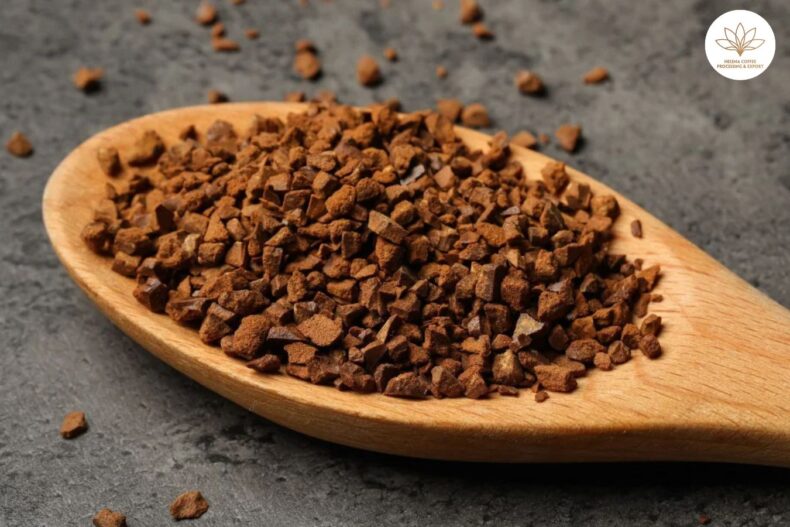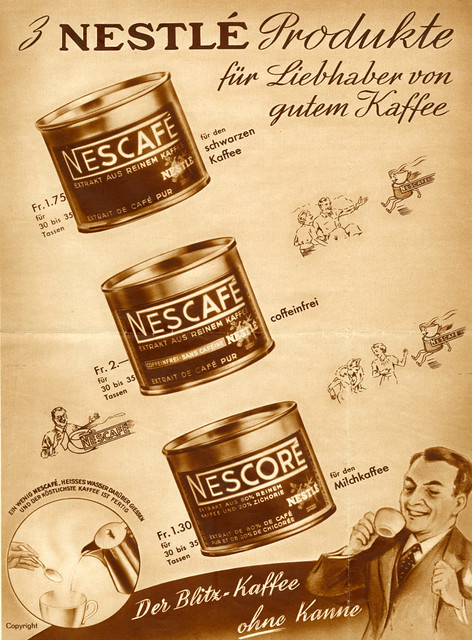
History Of Instant Coffee: Most of us think that the heyday of instant coffee is over. Famous names like Folgers, Maxwell House, Nescafe, or “classy” like Starbucks VIA are gradually falling behind the wave of Specialty Coffee.
Despite the convenience in the industrial age, fewer and fewer people opt for instant coffee. However, more than a century after birth, with a history of many fluctuations, instant coffee has never tended to come to an end.
The first inventions of instant coffee
Like many innovations in the food industry, the provenance of instant coffee is continuously evolving through various patents. According to Mark Pendergast in The Oxford Companion to American Food and Drink – Instant coffee was first born in 1771 (about 200 years after coffee was introduced to Europe). The patent belongs to John Dring ( Brother)

In the late 19th century, the Glasgow company invented Camp Coffee, a liquid blend consisting of water, sugar, 4% caffeine-free coffee grounds, and 26% chicory (19th-century coffee history shows the roots).
The French once used chicory during the Napoleonic era because of the scarcity of coffee). In the United States, instant coffee was still new and was only used by soldiers during the Civil War in 1853. Meanwhile, commercial versions of Camp Coffee were popular in the market. UK retail.
The first wave of instant coffee
Back to America after the war. This is the period of solid development of instant coffee, which the history of the coffee industry has recorded as the “first wave of coffee” led by two “giants,” Folger and Maxwell House.
About Folgers
The predecessor of the Folgers Instant Coffee Company was founded in 1850 in California under the name “Pioneer Steam Coffee and Spice Mills. “ The owner is William H. Bovee. To build the factory, Bovee hired James A. Folger to work. By 1865, James A. Folger had become a partner of The Pioneer Steam Coffee and Spice Mills. And in 1872, he bought out other shareholders and renamed the company JA Folger & Co.

In 1889, James died, and his oldest son, James A. Folger II, stepped into the role of president of JA Folger & Co at the age of 26. During the 1900s, the company began to grow exponentially with the construction of the Folgers coffee factory in Texas.
Since the mid-20th century, under the leadership of Peter Folger, this brand has been a significant influence on the North American coffee industry – the largest coffee market in the world. In 1963 P&G (Procter & Gamble) bought Folger’s instant coffee brand and removed the apostrophe from its name.
And Maxwell House
In 1884, Joel Cheek met Roger Nolley Smith – an English coffee broker, the two of whom were researching the perfect coffee blend. And in 1892, Cheek successfully marketed instant coffee to the Maxwell House hotel (Maxwell House bought the exclusive rights to Cheek’s instant coffee).
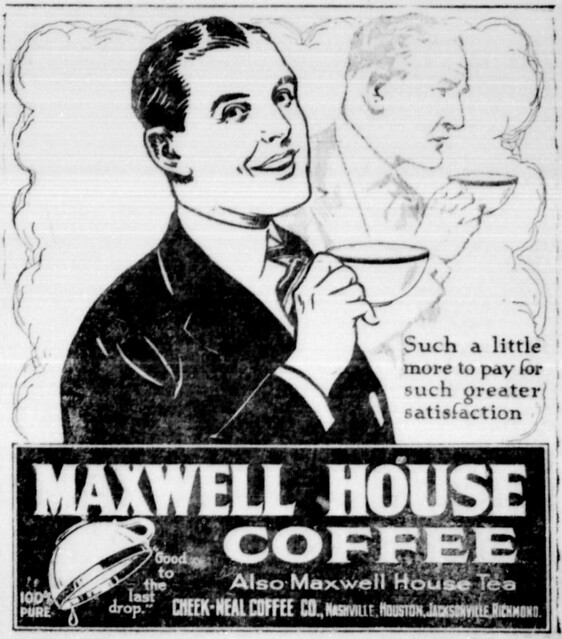
This initial step prompted Cheek to set up a distribution company with a primary partner, Maxwell Colbourne, Nashville Coffee, and Manufacturing Company. Later, Nashville was renamed the Cheek-Neal Coffee Company.
Over the next few years, the Maxwell House Coffee brand became popular. In the 1920s, through advertising, the Maxwell House brand became widely known throughout the United States.
Back to the main issue, both Folger and Maxwell House brands were not successful with coffee quality because most of them used poor quality coffee and limited technology. Hour. However, the convenience and speed helped the above brands to lead the coffee industry at that time.
- See also Coffee industry marketing history; you can see how instant coffee can take its market share.
Inventions of the early 20th century
According to the two famous names, instant coffee is still relatively new at this stage. From the late 19th century to the early 20th century, a series of terms associated with the invention and reinvention of instant coffee include:
- David Strang (New Zealand) applied for a patent for “instant coffee powder” in 1890 under the name Strang’s Coffe. Strang also filed a patent for a new roasting apparatus (coffee-roasting apparatus of novel design) and a Hot Air Grain Dryer (Strang’s Eclipse Hot Air Grain Dryer).
- Japanese chemist Sartori Kato introduced Buffalo coffee powder at the Pan-American Exposition (New York) in 1901.
- By 1906, Cyrus Blanke introduced a new coffee powder to the market. From a random idea: While having lunch at Cafe Tony Faustin St. Louis. When he poured a drop of coffee onto a plate of hotcakes, the coffee dried immediately, leaving behind a dry brown powder. Then he realized that it was back to normal when he added the coffee water. This led to the birth of instant coffee Faust Coffee, which Blanke named after the cafe.
- Four years later, a European immigrant named George Washington refined the first commercially viable instant coffee in the United States, which became popular during World War I for its convenience.

Washington’s instant coffee appeared in the New York Tribune in 1919 Quality improvements of instant coffee
It wasn’t until 1938 that instant coffee technology changed markedly. This year, Nestle launched Nescafé with spray drying technology. Nescafé remains one of the most popular instant coffee brands.
In 2012, Nescafé accounted for 50% of the 3in1 instant coffee market (mixture of coffee, milk, and sugar) and 74% of the instant coffee market.
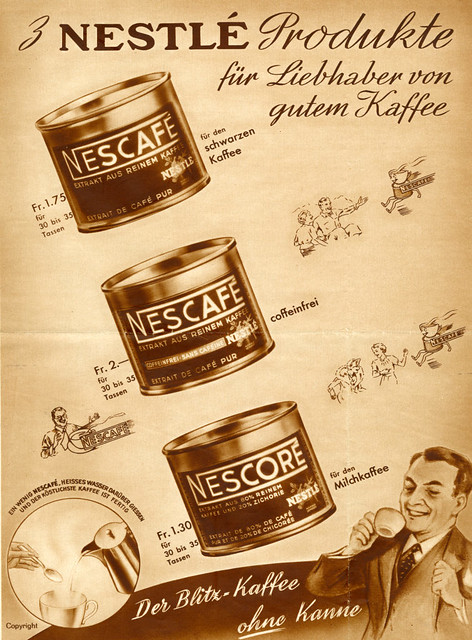
Nescafe instant coffee advertisement in the 1930s In the book Coffee and Tea, author Joel Schapira quotes: “In the early 1940s, instant coffee was often added with about 50% carbohydrates to “thicken” the product.
- Until the 1950s, more sophisticated dehydration techniques were developed and larger size instant coffee beans were produced. However, there was still one incomplete element: the wonderful aroma of the coffee beans. freshly ground coffee.”In the 1960s, manufacturers added oil from the beans to recreate the scent of fresh coffee. When the customer opens the jar, the smell of coffee comes out, but the odors disappear as soon as it is stirred. Not only that, the added oils increased the oxidation potential of the product, a situation that remained until the mid-60s.
Freeze-dried, the turning point of instant coffee
The most significant innovation in instant coffee technology was born in 1964 with “freeze-dried.” In this technique, the coffee mixture is cooled to freezing, then pressurized to change the water from a solid to a gas (sublimation), leaving the coffee mass with its carbohydrate components.
This is the primary technique for producing instant coffee (and many agricultural products). This technique helps maintain the taste and smell of fresh coffee without adding oil.
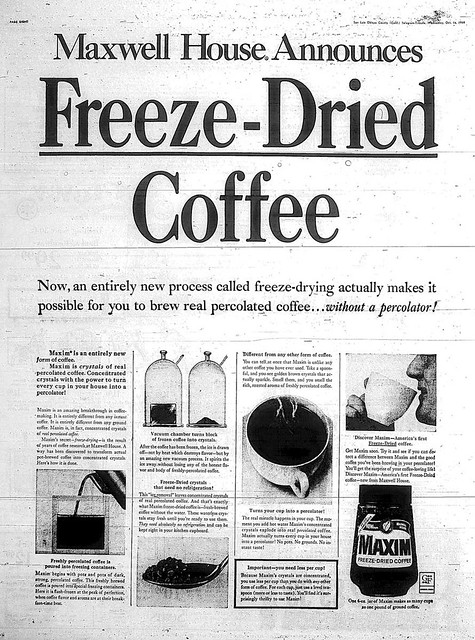
Advertisement Maxim freeze-dried coffee by Maxwell House in 1968 Sublimation has changed the mass production of instant coffee because the finished product looks like ground coffee and has a better taste (although the process is more expensive than spray drying).
After the drying turning point opened in the late 1960s, agglomeration techniques were more focused on the production of instant coffee. To make the coffee crystals clump together into “cubes” that look like freshly ground coffee for better organoleptic performance.
Today, nearly 50% of the world’s green coffee is used to produce instant coffee, of which it is still mainly Robusta coffee.
Decline & saturation phase of instant coffee
By 1989, instant coffee saw the beginning of a massive drop in sales. Coffee shops that focus on quality and
experience are more popular. The counterbalance that used to be the advantage of instant coffee “convenience” has been overwhelmed by the wave of specialty coffee, led by Starbucks. Big companies, like Maxwell House, have seen sharp declines in revenue.
In the 1990s, Nestle’s Taster’s Choice product was launched as a truly “delicious” instant coffee, but it couldn’t make up for the growing American preference for freshly brewed coffee.
Despite the dominance of the US coffee market and the bleak reality of instant coffee. Starbucks still launched the VIA product in September 2009 with its “micro-ground” technology. President and CEO Howard Schultz predicted the product would “change the way people drink coffee,” but it didn’t take over the coffee market; Americans still love their espresso.

Starbucks VIA Instant Coffee But outside the US borders, instant coffee has begun to tap into new markets: As of 2013 in the UK, tea sales are down 17.3%, while Nescafé instant coffee sales are up at a flat rate. 6.3%. And in China – The country of tea drinkers (coffee drinking rate used to be 2 cups/person/year) is now the world’s largest instant coffee consumption market.
Big names like Folgers, Maxwell House, or Nescafe have retired from their heyday, but in reality, instant coffee sales have remained steady for decades or more. Instant coffee still holds its ground next to authentic espresso.
Related posts:
- The beginning of coffee roasting history – Helena Coffee
- Coffee history, from discovery to commercialization
- A brief history of coffee marketing
Reference source:
- www.en.wikipedia.org/ Instant coffee
- www.smithsonianmag.com/ Is There a Future For Instant Coffee

